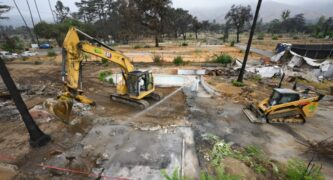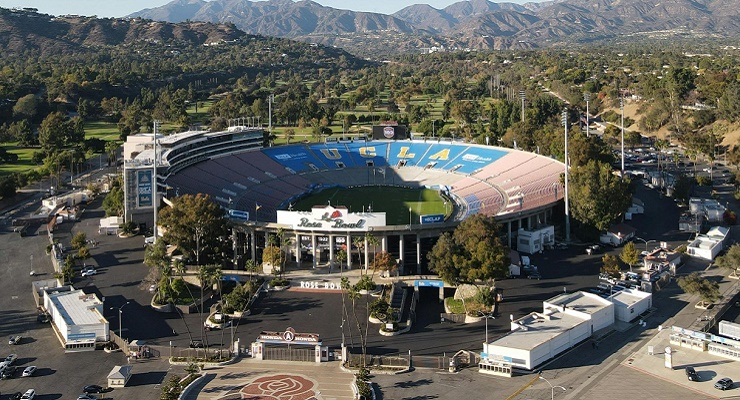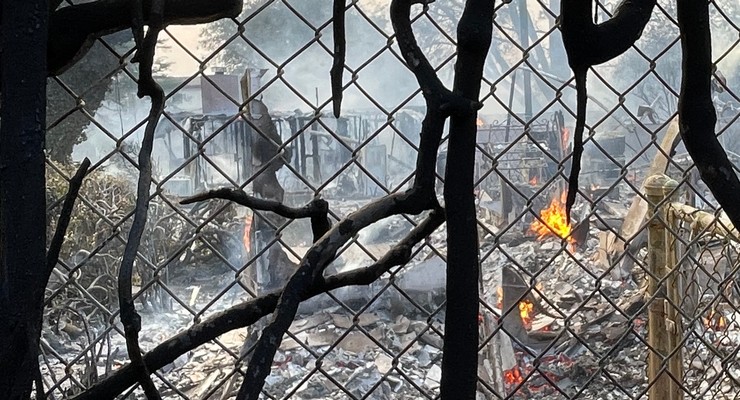
The eight-month turnaround is a significant increase over the Paradise Fire.
The Eaton Fire burned more than 9,000 acres in January, leveling neighborhoods in the foothills above Pasadena.
With the debris removal program now complete, county leaders say rebuilding could kick into high gear before the one-year anniversary of the blaze — a milestone unthinkable for Paradise residents in the first years after their catastrophe.
Locally, the Army Corps of Engineers, working in tandem with the EPA and Los Angeles County, hauled away more than a million tons of burned concrete, twisted metal and contaminated soil from hundreds of homes.
Crews also recycled large portions of the material — crushing concrete for reuse in construction, sending scrap metal to mills, and re-purposing downed trees as mulch or lumber.
The increased pace was established early on.
“This may be one of the largest jobs EPA has ever encountered with regard to natural disaster debris collection,” said Harry Allen, on-site EPA coordinator after the Eaton Fire.
“We have to move five times the speed based on the directives we are getting. Normally, this takes months.”
After the fire, federal disaster officials said it could take more than a year to clear all the debris.
An executive order signed in January by President Trump ordered a fast-tracking of debris removal. Also, recycling cement and other items also led to fewer trips to landfills.
Supervisor Kathryn Barger also pushed a faster pace by prioritizing local coordination.
“She quickly partnered with Mayor Karen Bass to ensure Los Angeles County took the lead in supporting the Army Corps of Engineers, with a focus on helping residents enroll in the debris removal program,” said Helen Chavez, Barger’s spokesperson.
“Under her direction, the County’s Public Works Department rapidly built a management structure, brought in outside expertise, and used GIS mapping tools to identify where Right of Entry forms were missing so entire blocks could be cleared at once.”
Barger also worked hand in hand with the Altadena Town Council, local stakeholders, and community members to spread the word, while providing consistent updates through newsletters, social media, and weekly community meetings.
That combination of outreach, coordination, and resource scaling gave the Army Corps the tools they needed to move more efficiently in Altadena.”
That pace stands in contrast to the aftermath of the 2018 Camp Fire in Paradise, the deadliest and most destructive wildfire in California history.
Cleanup there stretched nearly two years as crews faced contamination of the water system, asbestos-laden debris and almost 19,000 destroyed structures. Utility restoration alone took more than 18 months, and full rebuilding continues today.
One year after the cleanup only 14 homes had been rebuilt.
The cleanup in Maui following the 2023 wildfires fell between the two. The Lahaina blaze destroyed more than 2,200 buildings and left at least 101 dead.
After the U.S. Environmental Protection Agency cleared hazardous waste, the Army Corps of Engineers began large-scale debris removal in November 2023.
By July 2024 — less than a year after the fire — most residential lots had been cleared, though soil testing and environmental monitoring extended into early 2025.
Residents in all three communities faced the same first step: granting Right of Entry forms that allowed government crews to clear hazardous materials before heavy equipment moved in.
Altadena’s cleanup moved faster largely because of scale and complexity. The Eaton Fire destroyed less than 10,000 structures compared to the nearly 19,000 lost in Paradise. More than 2,200 structures were destroyed in Lahaina, Hawaii making the cleanup in the Eaton and Lahaina fires smaller and more manageable.
Also, unlike Paradise, Altadena’s water system wasn’t contaminated with benzene, and unlike Maui, officials didn’t face island disposal limits or sensitive historic sites.
Crews in Altadena also emphasized recycling concrete, metal and trees on site, reducing trucking and landfill delays.
Most importantly, agencies applied lessons from earlier disasters, streamlining contracts and property access paperwork to shave months off the process.



















